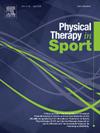The effect of anti-pronation and anti-supination taping on neuromuscular control in recreational athletes with Achilles Tendinopathy: A randomized controlled cross-over trial
IF 2.2
3区 医学
Q1 REHABILITATION
引用次数: 0
Abstract
Objectives
To investigate the effects of different directions of athletic taping on neuromuscular control of the lower limb in recreational athletes with Achilles tendinopathy (AT).
Design
Crossover Study.
Setting
Functional assessment laboratory.
Participants
Thirty recreational athletes with AT.
Main outcome measures
Participants were randomly treated with anti-pronation taping, anti-supination taping, or no-taping. Under different taping conditions, neuromuscular tests were performed in random order: ankle proprioception Active Movement Extent Discrimination Assessment (AMEDA), Weight-Bearing Lunge Test (WBLT), single leg hop test, figure-of-eight hop test and Lower Extremity Functional Test (LEFT).
Results
Compared with no-taping, both anti-pronation taping and anti-supination taping significantly improved AMEDA proprioception test scores (p < 0.001,ηp2 = 0.466), figure-of-eight hop performance (p < 0.001,ηp2 = 0.307), unilateral LEFT scores (p < 0.001,ηp2 = 0.448), and may reduce risk of lower limb injury in recreational athletes with AT (p < 0.001,ηp2 = 0.432). Taping significantly reduced WBLT values (p < 0.001,ηp2 = 0.259) but had no significant effect on single leg hop test scores (p = 0.139). Importantly, no difference between the two taping conditions was observed.
Conclusions
Both directions of athletic taping were equally effective in improving ankle proprioception, lower extremity functional performance, and reducing the risk of injury in athletes with AT, but had no significant effect on lower limb explosive strength and were associated with significantly reduced ankle dorsiflexion.
抗旋前和抗旋后贴敷对休闲运动员跟腱病神经肌肉控制的影响:一项随机对照交叉试验。
目的:探讨不同方向运动贴敷对休闲运动员跟腱病(AT)下肢神经肌肉控制的影响。设计:交叉研究。单位:功能评估实验室。实验对象:30名娱乐性AT运动员。主要结果测量:参与者随机接受抗旋前、抗旋后或无旋后治疗。在不同的贴带条件下,随机进行神经肌肉测试:踝关节本体感觉主动运动程度辨别评估(AMEDA)、负重弓步测试(WBLT)、单腿跳测试、八字跳测试和下肢功能测试(左)。结果:与未包扎相比,抗旋前和抗旋后包扎均能显著提高休闲AT运动员AMEDA本体感觉测试得分(p p2 = 0.466)、八字跳成绩(p p2 = 0.307)、单侧左肢得分(p p2 = 0.448),并可降低下肢损伤风险(p p2 = 0.432)。带带显著降低了WBLT值(p p2 = 0.259),但对单腿跳测试分数没有显著影响(p = 0.139)。重要的是,没有观察到两种胶带条件之间的差异。结论:两种方向的运动胶带在改善AT运动员的踝关节本体感觉、下肢功能表现和降低损伤风险方面同样有效,但对下肢爆发力没有显著影响,且与显著减少踝关节背屈有关。
本文章由计算机程序翻译,如有差异,请以英文原文为准。
求助全文
约1分钟内获得全文
求助全文
来源期刊

Physical Therapy in Sport
医学-康复医学
CiteScore
4.50
自引率
8.30%
发文量
125
审稿时长
39 days
期刊介绍:
Physical Therapy in Sport is an international peer-reviewed journal that provides a forum for the publication of research and clinical practice material relevant to the healthcare professions involved in sports and exercise medicine, and rehabilitation. The journal publishes material that is indispensable for day-to-day practice and continuing professional development. Physical Therapy in Sport covers topics dealing with the diagnosis, treatment, and prevention of injuries, as well as more general areas of sports and exercise medicine and related sports science.
The journal publishes original research, case studies, reviews, masterclasses, papers on clinical approaches, and book reviews, as well as occasional reports from conferences. Papers are double-blind peer-reviewed by our international advisory board and other international experts, and submissions from a broad range of disciplines are actively encouraged.
 求助内容:
求助内容: 应助结果提醒方式:
应助结果提醒方式:


